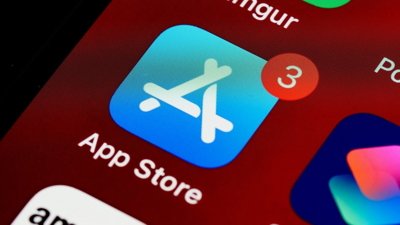The iOS SDK simulator can render an app's images, user interface controls and text at the resolution of both the existing iPhone/iPod touch (320x480) and the new iPhone 4 (640x960).
The detail photo shown below, provided by an iOS developer, presents both images at the same scale, illustrating the difference the higher resolution density makes in text clarity and graphics.
Note that bitmapped images created at the iPhone's exiting resolution, including the "ai" logo and the "search AI" field in the AppleInsider mobile web page (shown below), are not affected by the increased resolution and will need to be updated to appear as sharp as the native controls used in the Safari app.
Text and vector images are rendered at the full resolution, however, without any work by the mobile app or web sites.
This capture of Safari operating in landscape orientation with its keyboard visible shows off the additional clarity and sharpness delivered by the iPhone 4's new display.
The iPhone 4's 326ppi TFT Retina Display leapfrogs existing high end Android phones with resolutions of 480x854 TFT (Verizon Droid, 265ppi) or 800x480 OLED (Nexus One / HTC Incredible, 254ppi, but drops pixels to deliver an effective subpixel resolution of 392x653) or 480x800 TFT (HTC Evo, 217ppi due to being a larger screen).
While a large number of the more than 50 million existing iPhone users worldwide are likely to upgrade to the new iPhone 4, Verizon and Sprint users who just signed two year contracts on Android phones in the last six months are unlikely to race out to buy the next higher resolution devices that become available, particularly given that US service providers are now forcing users to pay as much as $350 in early termination fees.
 Daniel Eran Dilger
Daniel Eran Dilger










 Malcolm Owen
Malcolm Owen
 William Gallagher
William Gallagher
 Andrew O'Hara
Andrew O'Hara

 Sponsored Content
Sponsored Content
 Charles Martin
Charles Martin










35 Comments
Man, we STILL can't escape the mobile-formatted version of AI...
While a large number of the more than 50 million existing iPhone users worldwide are likely to upgrade to the new iPhone 4, Verizon and Sprint users who just signed two year contracts on Android phones in the last six months are unlikely to race out to buy the next higher resolution devices that become available, particularly given that US service providers are now forcing users to pay as much as $350 in early termination fees.
[ View this article at AppleInsider.com ]
Well...seems like you can either pay the 599 contract-free price, or get the 299 early-term price, in which case if you leave, it costs you about 599...give or take.
Man, we STILL can't escape the mobile-formatted version of AI...
Actually, we just worked on overhauling it. It looks almost the same but functions differently, hopefully more towards everyone's liking. I'll make it live shortly.
K
All that sharpness and useable in daylight too. I’ll take one!
By the way, some of the article images are actually shown smaller (with the softening that scaling causes) than the pixel size of the actual iPhone 4. So the real thing would be even higher-res and sharper. The big keyboard images are 600 tall instead of 640. (I’m not looking at the cropping, but actual scaling.)
Note that bitmapped images created at the iPhone's exiting resolution, including the "ai" logo and the "search AI" field in the AppleInsider mobile web page (shown below), are not affected by the increased resolution and will need to be updated to appear as sharp as the native controls used in the Safari app.
What are the implications of this? And I am quite shocked no one is talking about it!
Are we now going to see web pages grow larger in terms of filesize, chewing up bandwidth, only because web designers are now going to start saving bitmap graphics at higher resolutions than 72dpi, so they display more sharply on the iPhone 4?